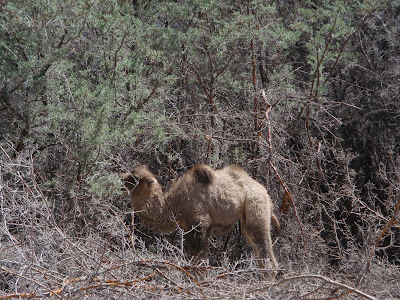I had my breakfast at the guest house - Ladakhi bread, Apricot jam (lovely).
There was a bus passing that way carrying school children and villagers. My owner stopped it and I ran. I sat by the window. The bus moved slowly through the village showing unexpected scenes at every turn - fields, gardens, people, their neat houses and the faraway mountains. What a delightful ride it was.
I was dropped off at the main road from where I took another bus that was to pass by the desert. I got down when I was asked to. Here.
I could see at a long distance away some dots that were supposed to be the camels with their caretakers. I walked into the desert. Up and down sand dunes. I lost perspective and sense of direction for sometime. And then when I climbed to the top of a sand dune, I could see the camels again and I was relieved. I walked on with difficulty, heaving my feet that were buried in sand.
And then at last I saw two men on a sand dune some 100 meters away. They were looking for a memory card that a traveller had dropped. They talked to me. I was happy and cheerful again. Its so nice to be spoken to by another human being when you are lost in a strange land.
I followed them to their settlement.

I had to cross a small stream of clear water on a makeshift wooden bridge. Ah! This place and its never ending surprises!
300 rupees for a 15 minute ride. That was the deal.
And I rode the Bactrian camel!!!
One of the caretakers walked me till the main road from where I was to take another bus to Diskit.
My first experience of a desert. In the least expected place - the midst of snow capped mountains!
"The desert is one of the highlights of a Nubra visit. Against the backdrop of the rugged reddish brown mountains, the rolling sand dunes seem truly out of the world. A pair of double humped Bactrian camels, treading through the sands in the distance, often completes the scene. The desert is just by the road that connects Distkit and Hundar. A vast stretch of sand dunes that seems to have been transplanted from the Sahara or perhaps the Gobi.
Hundar’s greatest attraction is the Bactrian camel safari. Strange double humped shaggy-haired animals. Not as tall as their single humped Saharan and Rajasthani cousins, they have 2 coats, -a down inside layer and an outer rough covering - to help survive the intense cold and winds of the Gobi. They have bushy eyebrows and nostrils that can close and ears lined with thick hair all to protect against the ferocious wins and dust storms. The animals can drink upto 120 litres of water at a time and carry almost 200 kg.
Nubra’s Bactrian camels are leftovers of the Central Asian trade. A native of the Gobi desert and its surrounding regions, they were used extensively on the trade route to Yarkand. But when the trade abruptly ceased in 1949 following the communist takeover of China, the animals on this side of the border became superfluous. Some of the herds had been brought here over a hundred years ago from Hunza, in what was once the far northwest of J&K state (and now ruled by Pakistan),. In 1960’s and 70’s, many of the animals tuned feral as their owners, Muslim Baltis settled in Diskit and Hundar, let them loose; their numbers declined alarmingly. But with the arrival of tourists, the camels have again become valuable to their owners and are now well cared for."




































No comments:
Post a Comment